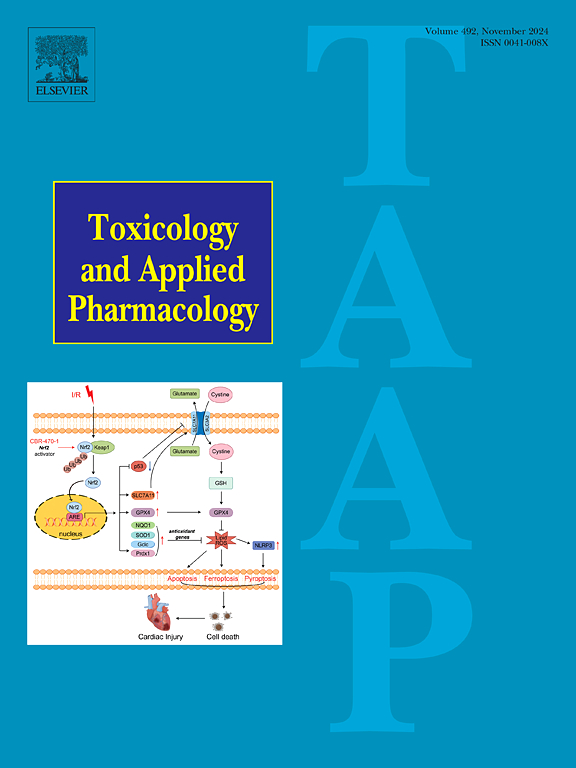Mouse nephron formation is impaired by moderate dose arsenical exposure
IF 3.3
3区 医学
Q2 PHARMACOLOGY & PHARMACY
引用次数: 0
Abstract
Millions of people are exposed to concentrations of arsenic that exceed the World Health Organization's limit of 10 μg/L. Inorganic arsenic (iAsIII) is metabolized by arsenic 3 methyltransferase (As3mt) that converts it to methylated arsenicals, mono and dimethyl arsonous acid (MMA and DMA). Chronic arsenic exposure is linked to an increased risk of chronic kidney disease (CKD), however, the effects of arsenic exposure on kidney development remain unclear. We hypothesized that exposure to arsenicals impairs nephron formation during mouse kidney development. Mouse embryonic kidney explants were treated with iAsIII and MMAIII (1.5 μM or 200 μg/L). iAsIII inhibited growth of kidney explants and ureteric bud branching morphogenesis at embryonic day 11.5 (E11.5) and E12.5, but not at E13.5. Similar effects were observed when kidney explants were treated with MMAIII. Additionally, iAsIII exposure increased apoptosis in the metanephric mesenchyme of E11.5 explants and decreased Gdnf transcription. To assess the impact of iAS exposure in utero and early postnatal life, female mice harboring a humanized version of AS3MT and wild-type mice with murine As3mt were exposed to iAsIII throughout gestation and weaning and their offspring were analyzed for kidney defects. Pups with human AS3MT exposed to 1.5 μM iAsIII in utero, showed a 20 % reduction in kidney weight normalized to body weight and a 28 % reduction in nephron number, compared to kidneys of wild-type mice.
In conclusion, exposure to arsenicals during embryonic development impairs ureteric bud branching morphogenesis and decreases nephron endowment, which may predispose to CKD in adulthood.

中等剂量砷暴露可损害小鼠肾元形成
数百万人暴露在超过世界卫生组织规定的10微克/升的砷浓度的环境中。无机砷(iAsIII)通过砷3甲基转移酶(As3mt)代谢,将其转化为甲基化砷,单甲基和二甲基胂酸(MMA和DMA)。慢性砷暴露与慢性肾脏疾病(CKD)风险增加有关,然而,砷暴露对肾脏发育的影响尚不清楚。我们假设在小鼠肾脏发育过程中,暴露于砷会损害肾元的形成。用iAsIII和MMAIII (1.5 μM或200 μg/L)处理小鼠胚胎肾外植体。iAsIII在胚胎第11.5天(E11.5)和E12.5天抑制肾外植体生长和输尿管芽分支形态发生,但在E13.5天无抑制作用。当肾外植体用MMAIII处理时,观察到类似的效果。此外,iAsIII暴露增加了E11.5外植体后肾间质的凋亡,降低了Gdnf的转录。为了评估iAS暴露对子宫和产后早期生活的影响,将携带人源化AS3MT的雌性小鼠和携带小鼠AS3MT的野生型小鼠在整个妊娠期和断奶期间暴露于iAsIII,并分析其后代的肾脏缺陷。与野生型小鼠相比,在子宫内暴露于1.5 μM iAsIII的人AS3MT幼崽的肾脏重量与体重相比减少了20%,肾单位数量减少了28%。综上所述,在胚胎发育期间暴露于砷会损害输尿管芽分支的形态发生,减少肾元的供能,这可能导致成年期CKD的易发。
本文章由计算机程序翻译,如有差异,请以英文原文为准。
求助全文
约1分钟内获得全文
求助全文
来源期刊
CiteScore
6.80
自引率
2.60%
发文量
309
审稿时长
32 days
期刊介绍:
Toxicology and Applied Pharmacology publishes original scientific research of relevance to animals or humans pertaining to the action of chemicals, drugs, or chemically-defined natural products.
Regular articles address mechanistic approaches to physiological, pharmacologic, biochemical, cellular, or molecular understanding of toxicologic/pathologic lesions and to methods used to describe these responses. Safety Science articles address outstanding state-of-the-art preclinical and human translational characterization of drug and chemical safety employing cutting-edge science. Highly significant Regulatory Safety Science articles will also be considered in this category. Papers concerned with alternatives to the use of experimental animals are encouraged.
Short articles report on high impact studies of broad interest to readers of TAAP that would benefit from rapid publication. These articles should contain no more than a combined total of four figures and tables. Authors should include in their cover letter the justification for consideration of their manuscript as a short article.

 求助内容:
求助内容: 应助结果提醒方式:
应助结果提醒方式:


